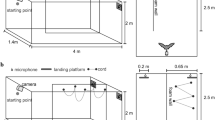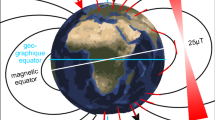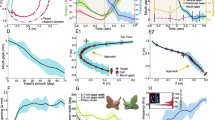Abstract
Previously, two studies have provided evidence that bats can use magnetic field cues for homing or roosting. For insectivorous bats, it is well established that foraging represents one of the most fundamental behaviors in animals relies on their ability to echolocate. Whether echolocating bats can also use magnetic cues during foraging remains unknown, however. Here, we tested the orientation behavior of Chinese noctules (Nyctalus plancyi) during foraging in a plus-shaped, 4-channel apparatus under different magnetic field conditions. To minimize the effects of spatial memory on orientation from repeated experiments, naïve bats were tested only once in each experimental condition. As expected, under geomagnetic field and a food resource offered conditions, the bats significantly preferred to enter the channel containing food, indicating that they primarily relied on direct sensory signals unrelated to magnetic cues. In contrast, when we offered food simultaneously in all four channels and minimized any differences in all other sensory signals available, the bats exhibited a clear directional preference to forage along the magnetic field direction under either geomagnetic field or a magnetic field in which the horizontal component was rotated by 90°. Our study offers a novel evidence for the importance of a geomagnetic field during foraging.




Similar content being viewed by others
References
Bell G (1985) The sensory basis of prey location by the California leaf-nosed bat Macrotus californicus (Chiroptera: Phyllostomidae). Behav Ecol Sociobiol 16:343–347
Carter GG, Ratcliffe JM, Galef BG (2010) Flower bats (Glossophaga soricina) and fruit bats (Carollia perspicillata) rely on spatial cues over shapes and scents when relocating food. PLoS One 5:e10808. https://doi.org/10.1371/journal.pone.0010808
Cresci A, Paris CB, Durif CMF, Shema S, Bjelland RM, Skiftesvik AB, Browman HI (2017) Glass eels (Anguilla anguilla) have a magnetic compass linked to the tidal cycle. Sci Adv 3:e1602007
Danchin E, Giraldeau L, Cezilly F (2008) Behavioural ecology. Oxford University Press, Oxford
Dubrov AP (1978) The geomagnetic field and life.Geomagnetobiology. Springer, New York, p 318
Firester AH (1996) Design of square Helmholtz coil systems. Rev Sci Instrum 37:1264–1265
Griffin DR (1958) Listening in the dark. Yale University Press, New Haven
Hessel K, Schmidt U (1994) Multimodal orientation in Carollia perspicillata (Phyllostomidae). Folia Zool 43(4):339–346
Holland RA, Thorup K, Vonhof MJ, Cochran WW, Wikelski M (2006) Bat orientation using Earth’s magnetic field. Nature 444:702
Holland RA, Kirschvink JL, Doak TG, Wikelski M (2008) Bats use magnetite to detect the Earth’s magnetic field. PLoS One 3(2):e1676. https://doi.org/10.1371/journal.pone.0001676
Holland RA, Borissov I, Siemers BM (2010) A nocturnal mammal, the greater mouse-eared bat, calibrates a magnetic compass by the sun. Proc Natl Acad Sci USA 107:6941–6945
Jones PL, Page RA, Ratcliffe JM (2016) To scream or to listen? Prey detection and discrimination in animal-eating bats. In: Fenton MB, Grinnell AD, Popper AN, Fay RR (eds) Bat bioacoustics. Springer, New York, pp 93–116
Li TT (2004) Tri-axial square Helmholtz coil for neutron EDM experiment. Chinese University of Hong Kong, p 23
Metzner W, Müller R (2016) Ultrasound production, emission, and reception. In: Fenton MB, Grinnell AD, Popper AN, Fay RR (eds) Bat bioacoustics. Springer, New York, pp 55–91
Mora CV, Acerbi ML, Bingman VP (2014) Conditioned discrimination of magnetic inclination in a spatial-orientation arena task by homing pigeons (Columba livia). J Exp Biol 217:4123–4131
Muchhala N, Serrano D (2015) The complexity of background clutter affects nectar bat use of flower odor and shape cues. PLoS One 10:e0136657
Rose A, Kolar M, Tschapka M, Knornschild M (2016) Learning where to feed: the use of social information in flower-visiting pallas’ long-tongued bats (Glossophaga soricina). Anim Cogn 19:251–262
Rydell J, Eklöf J (2003) Vision complements echolocation in an aerial-hawking bat. Naturwissenschaften 90:481–483
Schmidt U, Joermann G, Rother G (1988) Acoustical vs. visual orientation in neotropical bats. In: Nachtigall PE, Moore PWB (eds) Animal sonar processes and performance. Plenum Press, New York and London, pp 589–594
Schnitzler HU, Kalko EKV (2001) Echolocation by insect-eating bats. Bioscience 51:557–569
Schnitzler HU, Moss CF, Denzinger A (2003) From spatial orientation to food acquisition in echolocating bats. Trends Ecol Evol 18:386–394
Speakman JR, Anderson ME, Racey PA (1989) The energy cost of echolocation in pipistrelle bats. J Comp Physiol A 165:670–685
Thalau P, Holtkamp-Rotzler E, Fleissner G, Wiltschko W (2007) Homing pigeons (Columba livia f. domestica) can use magnetic cues for locating food. Naturwissenschaften 94:813–819
Thiele J, Winter Y (2005) Hierarchical strategy for relocating food targets in flower bats: spatial memory versus cue-directed search. Anim Behav 69:315–327
Tian LX, Lin W, Zhang SY, Pan YX (2010) Bat head contains soft magnetic particles: evidence from magnetism. Bioelectromagnetics 31:499–503
Walker MM, Kirschvink JL, Chang SBR, Dizon AE (1984) A candidate magnetic sense organ in the yellowfin tuna, Thunnus albacares. Science 224:751–753
Walker MM, Diebel CE, Kirschvink JL (2003) Detection and use the Earth’s magnetic field by aquatic vertebrates. In: Collin SP, Marshall NJ (eds) Sensory processing in aquatic environments. Springer, New York, pp 53–74
Wang YN, Pan YX, Parsons S, Walker M, Zhang SY (2007) Bats respond to polarity of a magnetic field. Proc R Soc B 274:2901–2905
Wegner RE, Begall S, Burda H (2006) Magnetic compass in the cornea: local anaesthesia impairs orientation in a mammal. J Exp Biol 209:4747–4750
Wiltschko R, Wiltschko W (1995) Magnetic orientation in animals. Springer, Berlin
Wiltschko W, Wiltschko R (2005) Magnetic orientation and magnetoreception in birds and other animals. J Comp Physiol A 191:675–693
Acknowledgements
We would like to thank Dr. Wei Lin for helpful discussions. This study was funded by the National Natural Science Foundation of China (Grant Numbers 41674071, 41621004) and the Chinese Academy of Sciences project (QYZDJ-SSW-DQC024).
Author information
Authors and Affiliations
Contributions
LT, WM, and YP conceived the experiments and wrote the paper; BZ and JZ collected the animals and performed the experiments; HQ adjusted the experimental magnetic fields; and TZ and YC analyzed the behavioral data. All authors reviewed the manuscript and approved the final version submitted.
Corresponding author
Ethics declarations
Conflict of interest
The authors declare that they have no conflict of interest.
Ethical approval
The Ethics Committee of the Chinese Academy of Sciences on Vertebrate Animals Experiments and the Institute of Geology and Geophysics Administrative Panel on Animal Care approved all experimental procedures. The collection of the bats was approved by the Institute of Geology and Geophysics, Chinese Academy of Sciences.
Additional information
Publisher's Note
Springer Nature remains neutral with regard to jurisdictional claims in published maps and institutional affiliations.
Electronic supplementary material
Below is the link to the electronic supplementary material.
Rights and permissions
About this article
Cite this article
Tian, L., Zhang, B., Zhang, J. et al. A magnetic compass guides the direction of foraging in a bat. J Comp Physiol A 205, 619–627 (2019). https://doi.org/10.1007/s00359-019-01353-1
Received:
Revised:
Accepted:
Published:
Issue Date:
DOI: https://doi.org/10.1007/s00359-019-01353-1




